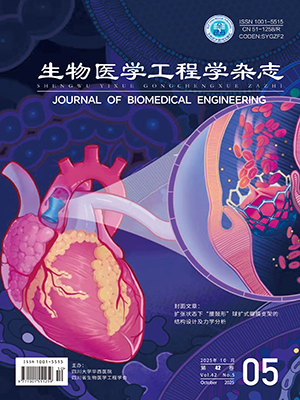This study aimed to verify whether the open-ended coaxial line tumor sensor with radio frequency was effective or not in detecting the differences in permittivity and conductivity between the breast malignant tissues and adjacent tissues. Sixteen breast infiltrating ductal carcinoma samples were freshly obtained from the department of general surgery in Zhujiang Hospital. The permittivity and conductivity of cancerous nidus points of breast samples, 3 cm adjacent tissue points and 5 cm adjacent tissue points were detected respectively by the open-ended coaxial line tumor sensor with radio frequency noninvasively in conjunction with vector network analyzer at the frequency ranging from 42.85~500 MHz. All the detected points were marked. After finishing the detection, we conducted postoperative pathological examinations on all the marked points. According to the statistics, there were statistically significant differences between the breast cancerous tissues and the 3 cm adjacent tissues for the dielectric properties (P < 0.01). There were statistically significant differences between the breast cancerous tissues and the 5 cm adjacent tissues for the dielectric properties (P < 0.01). There was no statistically significant difference in the dielectric properties between the 3 cm adjacent tissues and 5 cm adjacent tissues (P > 0.05). Both the 3 cm adjacent tissues and 5 cm adjacent tissues were found no breast cancer cell infiltration. The results indicated that the open-ended coaxial line tumor sensor at radio frequency could be effective in detecting the differences in permittivity and conductivity between breast cancerous tissues and adjacent tissues and, therefore, it may have a potential prospect in making a final diagnosis to confirm whether the detected breast tissue is malignant or not.
Citation: CHEN Miaoliang, CHEN Jianguo, WEI Shanshan, FU Fangxiang, XU Cailing, FENG Xiaochuang, DUAN Jingjing, LI Zhou, XIN Xuegang, HAN Shuai, WANG Weiwei, DUAN Song, DENG Guanhua. Experimental Research on Detection of Breast Carcinoma and Adjacent Tissues Based on Open-ended Coaxial Probe Tumor Sensor with Radio Frequencies. Journal of Biomedical Engineering, 2016, 33(5): 958-962. doi: 10.7507/1001-5515.20160154 Copy
Copyright © the editorial department of Journal of Biomedical Engineering of West China Medical Publisher. All rights reserved




